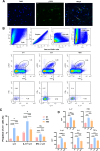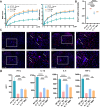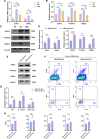IL-17 + γδT cell: a new target in hyperbaric oxygen treatment reducing spinal cord injury
- PMID: 41107988
- PMCID: PMC12535067
- DOI: 10.1186/s12967-025-07168-w
IL-17 + γδT cell: a new target in hyperbaric oxygen treatment reducing spinal cord injury
Abstract
Background: Hyperbaric oxygen (HBO) treatment can attenuate the inflammatory response after spinal cord injury (SCI), but the specific molecular mechanisms are unclear. γδT cells have emerged as key immune regulatory cells. This study aims to analyze the mechanism of HBO treatment reducing SCI mainly from the perspective of γδT cells.
Methods: Contusion SCI models were established in WT, TCRδ-/-, and IL-17-/- mice, and HBO treatment was performed. Hindlimb locomotor function, ChAT-positive motor neuron numbers, γδT cell proportion, and inflammatory cytokines level of different experimental groups were compared after SCI. Furthermore, we measured the protein and gene expression of STAT3 and RORγt in both WT mice and STAT3 overexpression mice following HBO treatment.
Results: Our results showed γδT cells, especially IL-17 + γδT cells, were involved in SCI. HBO treatment improved locomotor recovery, reduced the proportion of γδT and IL-17 + γδT cells, and decreased inflammatory cytokines in WT mice after SCI. However, HBO treatment did not affect locomotor recovery or inflammatory cytokines level in TCRδ-/- or IL-17-/- mice after SCI. In addition, HBO treatment significantly inhibited the expression of STAT3 and RORγt in WT mice after SCI. Over-expression of STAT3 weakened the inhibitory effect of HBO on IL-17 + γδT cells and inflammatory cytokines after SCI.
Conclusions: These findings indicated that IL-17 + γδT cells may play a key role in HBO treatment alleviating the inflammatory response after SCI. HBO treatment may regulate IL-17 + γδT cells by modulating the pathway of STAT3/RORγt. This study provides the theoretical basis and potential therapeutic target for HBO treatment in SCI.
Keywords: Hyperbaric oxygen; Inflammatory cytokines; Spinal cord injury; γδT cell.
© 2025. The Author(s).
Conflict of interest statement
Declarations. Ethics approval and consent to participate: All experimental procedures were conducted with the approval of the Ethics Committee of Beijing Chao-Yang Hospital, Capital Medical University (approval No. 2021-3-1-26). Consent for publication: All authors gave their consent for publication. Competing interests: The authors declare that there are no competing interests associated with the manuscript.
Figures






References
-
- Quadri SA, Farooqui M, Ikram A, Zafar A, Khan M, Suriya SS, et al. Recent update on basic mechanisms of spinal cord injury. Neurosurg Rev. 2020;43(2):425–41. - PubMed
-
- He X, Deng B, Ma M, Wang K, Li Y, Wang Y, et al. Bioinformatics analysis of programmed cell death in spinal cord injury. World Neurosurg. 2023;177:e332–42. - PubMed
MeSH terms
Substances
Grants and funding
LinkOut - more resources
Full Text Sources
Medical
Miscellaneous

